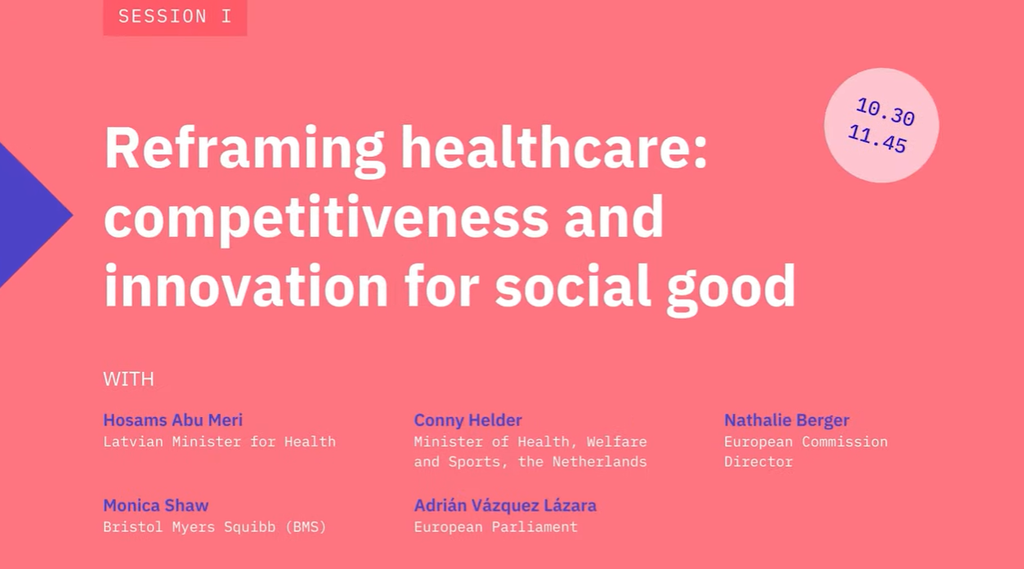Europe's moment: advancing clinical research and health innovation
Next event In person & online

- Area of Expertise
- Sustainable Livelihoods
Sustainable Livelihoods

Senior Research Fellow at the Clayton Christensen Institute for Disruptive Innovation
During the first half of the 20th century, healthcare was mostly about overcoming global infectious epidemics such as polio, small pox and tuberculosis. The high mortality rates and negative economic impacts from these diseases served as strong motivators for the medical community to find cures. Fortunately, scientific discoveries and innovations led to some diseases being fully eradicated during the second half of the century.
The worldwide impact of these life-saving discoveries has become palpable in recent decades, as the average life expectancy in developed countries has risen from the mid-50s in the early 1900s to over 80 by the end of the century.
Longer living, however, has brought new challenges to healthcare. Chronic diseases such as Alzheimer’s, diabetes, heart diseases and obesity typically manifest later in life, making them rapidly emerging epidemics. New forms of cancer and genetic diseases are also more frequently being discovered, increasing the complexity and the cost to healthcare systems. Providing affordable yet high-quality care for everyone has become the new global challenge.
The theory of disruptive innovation explains how new products and services in healthcare can be simpler, more affordable and more broadly accessible without compromising patient safety. Initially, disruptive innovations do not compete directly against established options. They instead find a foothold among new customers who are not utilising the existing solution, either because the product or service does not meet their needs or because it is too expensive or otherwise inaccessible.
For these customers, the new solution may adequately address their problem. Over time, a disruptive innovation improves and creates an entirely new market, thereby ‘disrupting’ the established solution.
During the first half of the 20th century, healthcare was mostly about overcoming global infectious epidemics such as polio, small pox and tuberculosis
Where will these innovations emerge in healthcare?
Most healthcare leaders and innovators associate disruptive innovations with technology, but that’s only a part of it. A key element of a disruptive innovation is its business model, in which technology in the form of a product or a service generates a profit when adopted by consumers. Healthcare’s established business model of consumers paying for each hospital or doctor visit through a third-party insurance plan has gone through several iterations over the past 50 years, but the core model has remained the same. Unless a new model emerges where payments are fully integrated into patient-physician interactions, we can expect little change to the system whose costs continue to inflate.
Therefore, disruptive innovations in healthcare are those that leverage existing or new technologies to offer healthcare services outside of the established care model. Emerging technologies such as sensors, wearables, software and diagnostic instruments that promote prevention and behavioural changes have significant potential to disrupt how healthcare services are paid for and offered.
Integrated health services models such as Kaiser Permanente and Intermountain Healthcare can potentially rewrite the rules on how healthcare products and services are valued because they process care services and payments under one roof.
Retail clinics that decentralise and unbundle routine healthcare services from centralised general hospital systems are also creating lower-cost models that can satisfy many customers who might find going to the hospital or doctor’s office to be too much of a hassle for routine care such as annual flu vaccines. The common theme of these disruptive models is that they reduce costs by simplifying delivery of care and payment.
Another important question is which healthcare stakeholders will drive these transformations? In many sectors, transformative power rests with consumers who determine which products and services succeed. But healthcare has a slightly different answer because it is highly regulated and because third-party insurance companies serve as payers. In fact, healthcare providers and payers have significant influence on patients and this asymmetry is likely to give them the central role in bringing change.
Disruptive innovations are the perfect antidotes for the growing problems of cost in healthcare
The spread of new business models will likely impact payers the most, as they determine how care services are paid, making them the key agent of change. The pressure on costs will only make the current third-party reimbursement system more difficult to sustain, as the reimbursement community will continue to demand that they are included in physician-patient interactions. Whether the model is a national single-payer system or a competitive model, payers will increasingly assert their presence between physicians and patients. We expect disruptive models in healthcare will either pull payers closer to providers and patients or cut payers out of the transaction.
It is similarly vital that providers support these types of transformations. By virtue of their authority as certified health professionals, they can dictate their future by embracing new models of care. Although daily activities of physicians, nurses and other healthcare providers will continue to change in coming decades, they will remain the most influential voices for consumers in making healthcare decisions. It is an opportunity, not a threat.
Much like how antibiotics and vaccines substantially lowered the mortality rates and cost of care for some of the most dangerous infectious diseases, disruptive innovations are the perfect antidotes for the growing problems of cost in healthcare. But the global community needs to remember that an innovative business model is at the heart of disruption.
Furthermore, no matter where the waves of healthcare disruption roll in, health providers and payers will be the stakeholders who scale the new model. Innovators will need to keep their channels open with these two groups and be ready to work with providers and payers to deliver transformations.
This article is part of Friends of Europe’s upcoming discussion paper ‘Disruptive models of healthcare for Europe’, which brings together the views of Friends of Europe’s large network of health professionals, policymakers, scholars and business representatives on disruptive innovation for health. This discussion paper closes a series of three high-level roundtables that Friends of Europe organised last year to examine the steps needed to create “disruptive models” for overhauling and improving healthcare systems across the EU.
Next event In person & online

Past event In person & livestreamed

Past event In person

Past event In person & livestreamed





Stay informed
We use cookies and similar technologies to adjust your preferences, analyze traffic and measure the effectiveness of our campaigns. Learn more about our privacy policy.